 LET’S FINGER-PAINT
LET’S FINGER-PAINT
The finger-painting workshop aims to facilitate the ability of self-expression through the interesting connection between the physical act of touching the paint and connecting with something important inside one’s self. Like yoga, finger-painting is a physical and spiritual opening up that helps you transcend and reach a different place within yourself, …allowing you to explore body, mind and soul. It’s a good activity to fully express yourself!
 What is Finger Painting?
What is Finger Painting?
You probably have childhood memories of sitting at a little table, dipping your fingers into thick, brightly colored paint and noodling your way around a sheet of smooth, shiny paper. These paintings were usually formless squiggle, blobs and lines created from a child’s carefree lack of inhibition. But finger painting isn’t just for children! Finger painting was a long-forgotten art form used by ancient people in North America, China and Europe. This activity has a spiritual component; like yoga, finger-painting is a physical and spiritual opening up that helps you transcend and reach a different place within yourself, allowing you to explore body, mind and soul.
Why Finger Painting?
• It is believed that it plays an important role in the emotional healing for people of all ages and abilities.
• The technique results in a real bond between the artwork & artist, it is a way to become more intimate with the process of painting.
• It encourages personal growth by providing a venue for an expressive medium.
• It does not require any particular talent to enjoy.
>>> Warning: It can be addictive for adults. The more you do, the better art you can create.
Who is the workshop (Course or Sessions) for?
The workshop is intended for people of all ages. It can work for both non-artists and artists (beginners or advanced).
It is for any person who wants to bring out his inner self through the interesting act of touching paint.
Theme: Free expressionism.
What is the Course’s schedule? The Course will consist of 8 sessions of two hours each.
Course Curriculum for Beginning Participants:
• Introduction to different genres of art movements (focus on finger painting)
• History of Finger Painting (artists that have used the art)
• Benefits of self expression
• How to finger paint (the tricks one’s fingers can do and the effect it creates)
• Composition
• Medias and Mediums
• The three key characteristics of Color
• Observation and Brain Storming
• Organization (from the preparation phase to the exhibition’s)
• Collective Painting (the visual language used to understand each other)
• Visual Performance art (the techniques each can develop and explore)
• How music affects Painting (experience new feelings generated on the spot)
• Workshops (in practice and theory, share what you have acquired)
Course Curriculum for Advanced Participants depends on the level of the participants. It mainly focuses on inspirational techniques, complexity in composition, media & medium technical use and refinement in finishing.
Things you’ll need to bring:
• paint of your choice, a canvas of any dimension, any media that you might want to use
to add texture and make the artwork memorable (e.g. old pictures, letters, old cloths, etc)
Wear comfortable clothes you would want to ruin with paint.
Things that are provided:
• gloves
• tea break.
A few media releases about the workshop:
Eleven things to do this week in BeirutPosted by Time Out Magazine: Aug 19 2011 http://www.timeoutbeirut.com/beirut/article/6723/eleven-things-to-do-this-week.html
As August continues and temperatures peak, try something new with our pick of this week’s ‘Twelve things to do this week’.
1. Go Sightseeing – in a plane. You haven’t seen it all until you’ve seen it from 9,000 feet up……..
5. Do some finger painting
If you’re up for exploring your mind, body and soul, this is one way in which to do it. Artist Kiki Bokassa will guide experimental adults through classes working on self-expression through the physical act of touching the paint.
Getting messy is the latest Lebanese trend
Nicole Sayegh, NOW Contributor , April 1, 2009
Students at the finger painting workshop in the Master Piece gallery in Hamra. (Nicole Sayegh)
In Rome, Italy, 1931, during one of the American educator Ruth Faison Shaw’s art classes, a young student of hers accidentally slit his finger. She handed the child iodine to help stop the bleeding. Instead of tending to the wound and continuing his artwork with traditional painting tools, the student began to use his finger and the iodine to paint. His accident led to the reintroduction of a long-forgotten art form of the ancient peoples of North America, China and Europe — finger painting.
“But it is not just for children!” exclaimed Marie-Ange J.B. Bokossa, or Kiki, a Beirut based-artist of Lebanese and Central African origin who is teaching the art form at the Master Piece Gallery in Hamra, Beirut. Kiki began painting with her hands in 1994 at the age of 18 after her trip to Africa to meet her father for the first time. “During my visit I felt the need to express what I saw, and so I began to write and paint, but obviously painting played a bigger role.”
Did she begin using brushes? “No, it never occurred to me to buy a brush. I knew others did, but it just wasn’t for me.” Painting with her hands has always been the form in which Kiki felt she could best create, “a little secret that I was ashamed to reveal, especially around professional artists.”
However, over time, as Kiki learned of the rich history of the art form and experienced its entertainingly creative and therapeutic attributes, she felt it was time to “reveal her little secret” to Beirutis. For the past three Saturdays, about a dozen adults, mainly women, ranging from their mid 20s to mid 50s, have, under Kiki’s instruction, been dipping their hands deep into colorful jars of paint and taking part in the “rewarding form of self-exploration and expression.”
As Kiki lectures the attendees of the workshop about the history of finger painting, self-expression, composition, media, the use of color, and the tricks to finger painting, the casual atmosphere allows one to follow her agenda or make your own. The single long table in the cozy gallery provides just enough room for the experience you are looking for.
Samara, who went into the March sessions with no expectations, enjoyed them so much that she was thinking of retaking the course in April. “It is a pity the session was so short,” she told NOW. Samara and her cousin Mira, both in their 30s, who live and work in Beirut, were looking for something to do “besides going to restaurants,” Mira said.
“This is sort of a mental break and very thought provoking,” Mira added. “After a long week at work, a friend of mine that called me during my last session said, ‘I hope you’re not painting with your middle finger.’”
The workshop functions as a fun stress-reliever for some, but a more serious time of reflection for others. Mira described the concept behind the work of one her classmates titled My Back and Me. The painting was a thick and dark depiction of the woman’s injured spinal cord covered with red and blue in an attempt to express her painful back problems.
Coverage: Master Piece Gallery (Journalist Nicole Sayegh)
“Some people applied the paint rigorously, some softly, some in lines, and others in circles… It was interesting to see that even though we all began our background with a single color, they all looked different,” Mira added.
Others took the opportunity to reflect, Sahar, 25, created an abstract painting of Adam and Eve with a large reddish-golden apple as big as the figures placed between them. Why did she choose to depict the Biblical story? “Because I believe the image men had of women since that time still exists. They still blame us for everything that goes wrong.”
For Hassan,55, it was the social aspect of the workshop that was the most appealing to him. “If I was a serious painter, maybe I would want to be alone, but part of the fun of this kind of workshop is that you are working and sharing with others.”
Art exhibition aims to revitalize southern psychiatric hospital
Foreign News – TG Italian Diplomacy – Published on February 18, 2010 Cooperation in the hospital Al Fanar
Mariangela Pira. A special day that experienced by patients of the psychiatric hospital “Al Fanar” in Lebanon. A well-known Lebanese artist, Kiki Bokassa, has created a painting session, think about it, a whole day, involving about 100 patients. The initiative is part of the emergency program Ross III, set up by the Italian Cooperation for the rehabilitation and support of this hospital. This innovative initiative, even more so if we consider that psychiatric hospitals in Lebanon are only three, and only one is located below the Litani River.

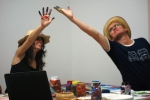
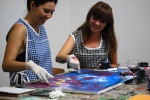
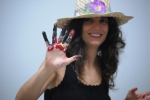
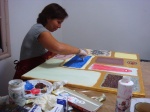
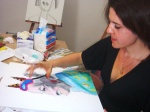






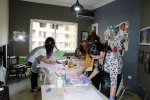

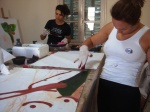
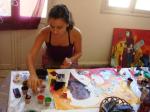
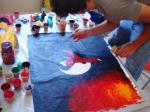






One thought on “Workshops”